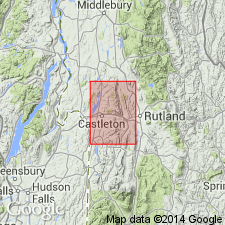
- Usage in publication:
-
- Columbian marble member
- Modifications:
-
- Revised
- Dominant lithology:
-
- Marble
- AAPG geologic province:
-
- New England province
Summary:
Pg. 25-26, 27, pl. 1 (corr. chart). Columbian marble member of Boardman formation (new). [Previously considered trade name for Ordovician age marble in western Vermont (USGS geologic names lexicon, USGS Bull. 896, p. 493). Included in list of formations by Bain (Amer. Jour. Sci., 5th ser., v. 22, p. 503-530, 1931) overlying Intermediate limestone and underlying West Blue deposit; of Chazy age.] Herein assigned to Boardman formation as its top member; name retained because of its economic importance in the marble belt. Generally white-weathering, white and blue-gray marble; occasional threads of green silicates wind irregularly through the white marble. Maximum thickness 600 feet. Underlies Bascom formation; overlies Intermediate dolomite member of Boardman. Correlative with Cutting dolomite of Cady (1945). Age is Early Ordovician (Canadian; Roubidoux provincial stage).
[Notable exposures in Addison and Rutland Cos., west-central VT. Not separately mapped on geol. map.]
Source: Publication; US geologic names lexicons (USGS Bull. 896, p. 493; USGS Bull. 1200, p. 896).
For more information, please contact Nancy Stamm, Geologic Names Committee Secretary.
Asterisk (*) indicates published by U.S. Geological Survey authors.
"No current usage" (†) implies that a name has been abandoned or has fallen into disuse. Former usage and, if known, replacement name given in parentheses ( ).
Slash (/) indicates name conflicts with nomenclatural guidelines (CSN, 1933; ACSN, 1961, 1970; NACSN, 1983, 2005, 2021). May be explained within brackets ([ ]).

